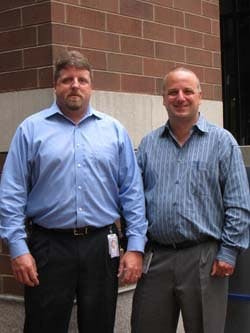Risk takers: Kenyon (left) and Dirienzo (right)
Last fall, Biogen Idec’s director of Quality, John Dirienzo, and its director of Manufacturing, Bob Kenyon, swapped jobs. Dirienzo went over to Manufacturing, and Kenyon to Quality.
It may sound like some frivolous, fish-out-of-water reality TV show, but for Biogen, the switch was strategic and the reality was, well, real.
Biogen Idec encourages creative career development and workforce flexibility. Job rotations are quite common; for instance, there is regular relocation of manufacturing employees between the company’s facilities in RTP, North Carolina, Cambridge, Mass., and Hillerød, Denmark. “You want to develop leadership across organizations, and develop people who have had a variety of experiences and are better at finding solutions,” Dirienzo says.
The job swap proposed for Dirienzo and Kenyon was the company’s first of its kind at such a high level. One thing the experiment had going for it was the two individuals involved. Dirienzo and Kenyon had been in their positions for more than a decade, working closely together the entire time.
Another plus was that the organization was ready for it, top to bottom. Management supported it, and the operational side of the business was stable. “Keep in mind,” says Kenyon, “that we did this switch on two very highly-functioning teams.”
They developed a plan that involved a staggered transition in which Kenyon moved over to Quality and shadowed Dirienzo. (If Kenyon were to assume control of Quality during a given production run, it might represent a conflict of interest.) After six weeks, Dirienzo relinquished his role and took over in Manufacturing.
Both men had doubts going in. “As a QA guy, I thought my compliance perspective might not be appreciated in Manufacturing,” Dirienzo says. Indeed, Quality and Manufacturing are often seen as different worlds. “In Quality, you need to step back, look at data, review proposals . . . it’s much more analytical,” he says. “There’s a lot more drive to be creative in Manufacturing. You make proposals and let Quality or Engineering or another group tell you why you can or can’t do it.” Despite his concerns, Dirienzo felt the opportunity was too good to pass up.
Kenyon also relished the challenge. “It was really a chance to broaden my horizons,” he says. It was an exciting prospect to learn about the Quality side of the business, or “life after drug substance,” as he puts it.
Dirienzo’s new turf required learning about steam systems, piping, chromatography equipment, and the physical equipment and space of manufacturing, and about capital planning, facility design, project prioritization. There were a few times early on that Dirienzo felt he would get “carved up” for a lack of knowledge. “Once I had a few successes, that went away.”
He had no illusions that he become a shop-floor expert. “You guys are going to have the opportunity to use your own experiences,” he told his new team. “It put a new emphasis on people taking responsibility for their own personal development.” When you’re in a leadership position for a long time, he adds, you can become too familiar with employees, play to their strengths, and not challenge them enough.
The experience has been liberating for employees, concurs Kenyon. As director of Manufacturing, he knew everything. As director of Quality, the tables were turned. “I had to shift to a greater empowerment of my staff,” he says. “I had to get more comfortable with really delegating and working through my staff.”
When the job swap was first made official, Dirienzo and Kenyon promised to give it at least two years. That won’t be a problem, Dirienzo says. “I’m having a blast,” he says. “Everything is so rapid and the job is changing so frequently, and I’m spreading myself across so many projects . . . .We need at least another year to get the full value out of it. After that, we’ll see.”
Kenyon says he still has much to learn. “A year later, I feel like I’m about half the way through,” he says.
Whatever the two do next, it will likely involve a leap of faith. “I believe you need to take risks in your development,” Dirienzo says. “The days of sitting in one chair and improving in a straight line are over. People may think it’s not right for them, but if you’re honest about wanting to develop your career and challenging yourself, you will take this risk.”
Says Kenyon, “It’s not the routine things that keep you interested. It’s the new twists.”





